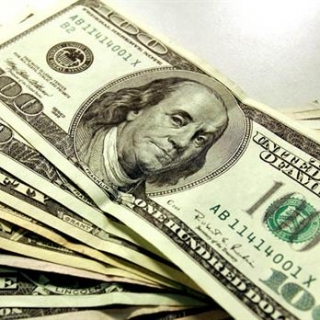


The US dollar struggled to regain lost ground on Wednesday as investors decided to take on more risk after a fragile ceasefire between Israel and Iran.
Markets cheered and global stock indexes hit record highs overnight as a shaky truce brokered by US President Donald Trump held sway between Iran and Israel. Both countries signaled that their air war was over, at least for now, after Trump publicly rebuked them for violating the truce he declared.
Investors sold the US dollar heavily after the news, having flowed into the safe-haven currency during the 12-day war between Israel and Iran that also saw the US strike on Iran's uranium enrichment facilities.
Movements in currencies were more subdued in Asia on Wednesday although the euro remained near its highest level since October 2021 and last bought $1.1614. Sterling weakened 0.03% to $1.3614 but was also not far from Tuesday's peak of $1.3648, which marked its strongest level since January 2022.
The risk-sensitive Australian dollar, which had rallied sharply in the previous session, was last trading 0.1% higher at $0.6496. The New Zealand dollar gained 0.33% to $0.6027.
Although the ceasefire between Israel and Iran appears fragile, investors for now appear to welcome any reprieve.
"The market is complacent about some of the downside risks," said Joseph Capurso, head of international and sustainable economics at Commonwealth Bank of Australia.
"My sense is that this is not over, which means it could come back as a driver of commodity prices and currency markets again."
In other currencies, the Swiss franc, which hit a 10-1/2-year high on Tuesday, was steady at 0.8052 per dollar. The yen weakened 0.1% to 145.03 per dollar.
Some Bank of Japan policymakers called for interest rates to be held steady for the time being due to uncertainty over the impact of U.S. tariffs on the Japanese economy, a summary of views at the bank's June policy meeting showed on Wednesday.
Against a basket of currencies, the dollar was little changed at 97.97.
While Federal Reserve Chairman Jerome Powell stuck to his cautious approach and reiterated that the central bank was in no rush to cut rates in his semi-annual testimony to Congress on Tuesday, markets continue to price in about an 18% chance that the Fed could cut in July, according to the CME FedWatch tool.
"We think slowing economic growth and a pick-up in services and housing inflation will push back against rate hikes, allowing cuts to resume in September," ANZ analysts said in a note. A string of weaker-than-expected U.S. economic data in recent weeks has strengthened expectations of a Fed rate cut this year, with futures indicating an easing of almost 60 basis points in December.
Data on Tuesday showed U.S. consumer confidence unexpectedly deteriorated in June as households grew more concerned about job availability, another sign that labor market conditions are weakening.
The yield on the two-year U.S. Treasury note, which typically reflects short-term interest rate expectations, fell to a 1-1/2-month low of 3.7870% on Wednesday.
The benchmark 10-year note was little changed at 4.3004%. (alg)
Source: Reuters
The dollar weakened on Thursday (October 9th), for the first time this week; most G-10 currencies weakened on the day, with the Australian and Canadian dollars outperforming the rest. The Bloomberg D...
The US dollar strengthened on Thursday (October 9th), continuing its gains this week, driven by a weaker euro due to the political crisis in Paris and a weaker yen amid a change in the ruling party le...
The dollar extended its gains for a third day on Wednesday, its longest winning streak since September 19. Most G-10 currencies weakened on the day, with the Canadian dollar outperforming the rest. T...
The dollar continued its strengthening for a second day, pressuring all G-10 currencies; the Japanese yen slumped for a fourth session to its weakest level since March before paring losses. The Bloom...
The US Dollar Index (DXY) continued its strengthening for a second day and briefly hovered around 98.20 during the Asian session, driven by hawkish comments from Kansas City Fed President Jeffrey Schm...
US President Donald Trump hit markets with a fresh tariff threat on Friday, continuing his lashout at China over their decision to impose even stricter export licensing requirements on foreign entities trying to move critical rare earths minerals...
Gold price rises during the North American session on Friday amid an escalation of the trade war between the US and China. This, the US government shutdown and expectation for further easing by the Federal Reserve (Fed) keep the yellow metal bid....
The Dow Jones Industrial Average (DJIA) soured sharply on Friday, plummeting to its lowest bids in nearly three weeks and declining over 1,000 points top-to-bottom after US President Donald Trump pulled out of upcoming trade talks with Chinese...
 European stocks held steady on Thursday after hitting new records the previous day, as investors awaited the latest news on the French political...
European stocks held steady on Thursday after hitting new records the previous day, as investors awaited the latest news on the French political...
 US stocks pulled back on Thursday as investors paused to digest optimism around AI, interest-rate cuts, and the ongoing government shutdown. The...
US stocks pulled back on Thursday as investors paused to digest optimism around AI, interest-rate cuts, and the ongoing government shutdown. The...
 European stock markets rallied on Wednesday, with equities in France perfomring strongly despite ongoing political upheaval in the country.
The...
European stock markets rallied on Wednesday, with equities in France perfomring strongly despite ongoing political upheaval in the country.
The...
 The S&P 500 and Nasdaq Composite reached new heights on Thursday as the market's march higher carries on.
The broad market index hovered around...
The S&P 500 and Nasdaq Composite reached new heights on Thursday as the market's march higher carries on.
The broad market index hovered around...